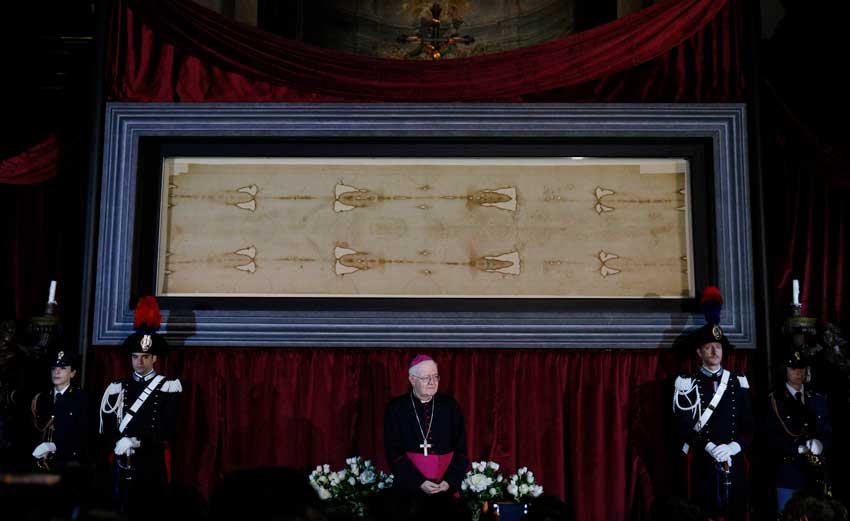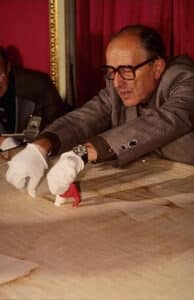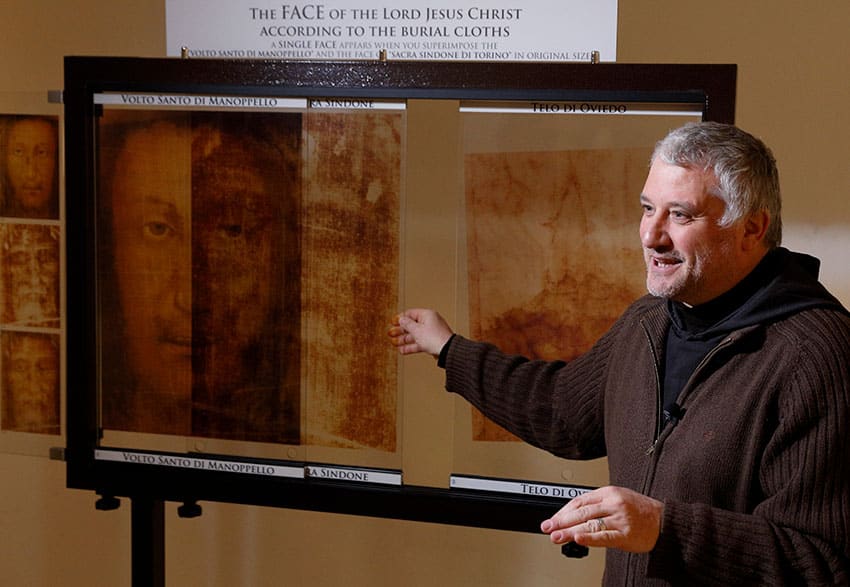
By William West
Although the Shroud of Turin once seemed to be discredited by carbon dating in the 1980s, new research has cast doubt on the carbon dating and produced dramatic evidence that the Shroud confirms the resurrection of Jesus.
I spent five years researching my recently-published book Riddles of the Shroud: Questions Science Can’t Answer, and the evidence suggests the Shroud covered Jesus at the point of resurrection.
The evidence is so strong that it is hard to imagine anyone with an open mind seeing it as anything less than compelling.
Despite the fact that most people seem to think research on the Shroud came to an end with the carbon dating in 1988, it has become the most researched single artefact in history.
The bottom line is that science has shown the image on the cloth is an ‘impossible’ image – one that cannot be replicated. One of the main reasons is, as scientists have now confirmed, the image on the Shroud had to be caused by a mysterious burst of light – that is, electromagnetic radiation.
In short, the evidence indicates the Shroud was wrapped around a real body that simply ‘dematerialised’ without disturbing the perfectly formed blood clots on the cloth. That could only happen through an event like that described in the Gospels as the resurrection – an event that, as the Gospels state, freed Jesus’ body from material constraints.“
The only evidence that has challenged the Shroud’s authenticity – the carbon dating – has now been shown to be flawed.
Raw data from the carbon tests, released after 29 years by a freedom-of-information action, has revealed that the tests were not definitive at all. This fact is confirmed by historical research indicating the Shroud was around long before the carbon date that dated it in the Middle Ages.
The evidence has been further strengthened by new dating tests that have dated the linen cloth to the first century.
And so, the only piece of evidence that appeared to contradict the Shroud’s authenticity, no longer makes sense.
Four research papers, authored by a total of 12 experts, have now been published in peer-reviewed academic journals, all agreeing the carbon dating was flawed and calling for a new carbon dating to be carried out.
This view has been supported by many Shroud researchers, including nuclear engineer, Robert A. Rucker, who has written extensively on the shortcomings of the carbon dating.
The call for a new carbon dating has also been supported by journalist Phillip Ball, a former editor of the journal that first published the carbon dating results, Nature journal.”
However, Church authorities should resist being pressured into further carbon-14 tests on the cloth for a number of reasons, including the fact that carbon dating the Shroud will never be definitive because the cloth is clearly contaminated and because the tests would be destructive.
When the carbon dating was first proposed, a multi-disciplinary committee of scientists recommended that seven samples from at least three separate areas of the cloth would be needed for carbon dating to be credible.

copyright 1978) (April 7, 1997)
But the carbon daters ended up taking only one sample and dividing it into three pieces.
Why would the Church agree to destructive testing now, testing that would require taking seven more samples of the cloth, given that the latest evidence indicates the Shroud has been contaminated by carbon-14?
And why do it at a time when the evidence that the Shroud is authentic is more powerful than ever?
At the same time, there are now newer, non-destructive dating tests that appear to be more accurate and less likely to be affected by carbon-14 contamination.
One of these tests, Wide-Angle X-Ray Scattering, recently dated the Shroud to the first century.
The results were released only last year by a team headed by a member of Italy’s National Research Council, Dr Liberato de Caro. The test is non-destructive and can be repeated many times using a single sample.
Three other dating tests by engineering measurements expert Professor Giullio Fanti and colleagues at the University of Padua have confirmed the first century date.
So, really, why would the Church rush into further carbon dating of the Shroud. Some researchers argue the evidence for the Shroud’s authenticity is now so compelling that further dating is unnecessary.”
The evidence that exists now confirms that the image on the 4-metre long cloth is an “impossible image” – one that can only be explained by some kind of “supernatural event”.
The fact is the image on the Shroud has never been replicated by science and that’s because the evidence suggests it can’t be. It is a high-resolution, photographic-negative, 3-D image caused by a discoloration of a uniform layer of microscopic linen microfibres – something that could only be caused by a finely tuned burst of electromagnetic radiation that came from the body itself.
The authenticity of the Shroud is supported by much more evidence than most people realise. Riddles of the Shroud lists 99 pieces of evidence that support its authenticity.
That evidence includes microscopic deposits on the Shroud of extremely rare soil found in Jerusalem and microscopic deposits of flower pollen from Jerusalem.
There is also chemical evidence that the blood on the cloth is high in the blood chemical bilirubin, something that is consistent with a body that has suffered some kind of torture.
The man who headed the carbon dating of the Shroud, the British Museum’s Dr Michael Tite, has stated that he has come to accept the cloth was not created by a medieval forger, as the carbon daters claimed at the time of the carbon dating.
Dr Tite said in a BBC interview that he believes the evidence indicates there was in fact a crucified body in the cloth.
He speculated that the man on the Shroud may have been a Christian crusader who was crucified in an act of humiliation by Moslem troops, but that version of events does not stand up to scrutiny – it doesn’t fit the evidence that points to a supernatural, rather than natural, event.
Nevertheless, Dr Tite’s comments provide an important admission that the Shroud was not ‘faked up’ by a medieval forger as the carbon daters claimed back in 1988 when they released the results that have now been widely criticised.
The evidence for the Shroud’s authenticity includes confirmation by forensic pathologists that the Shroud features anatomical and physiological information unknown in the Middle Ages.

The perfect wounds and blood deposits on the cloth were not disturbed by the removal of the body. When you dress a wound in a cloth bandage, it sticks hard, and when the bandage is removed, the blood clots break up and traces of flesh can be found on the cloth.
There is no evidence that the blood deposits on the Shroud have been disturbed. It appears that the body simply ‘dematerialised’ in a way that did not disturb the blood, at the same time leaving behind an image that could not have been created in the Middle Ages, any more than in the first century.
Despite extensive research by scientists, including chemists and physicists, there is no explanation of how the body disappeared.
The impossibly faint image that was left on the cloth indicates that this event was accompanied by a burst of light, which is the only thing scientists have found to be capable of reproducing the discoloration on the microfibres on a linen cloth.
In a fascinating twist to the carbon dating story, it turns out that electromagnetic radiation is also capable of increasing levels of carbon-14 on a linen cloth.
This was confirmed by the carbon daters themselves after a nuclear scientist wrote to Nature journal at the time the carbon dating results were released. But the carbon daters rejected this possibility because they said dead bodies don’t emit bursts of electromagnetic energy.
The problem is that they were focussed on the carbon dating and not on the evidence on the Shroud itself – evidence indicating that an extraordinary event had in fact taken place.
The evidence we have now makes it clear that this event involved a burst of electromagnetic energy – the very thing that can both explain the ‘impossible’ image on the cloth and the raised levels of carbon 14.
But despite this breakthrough, scientists are still unable to replicate the Shroud’s ‘impossible image’ – that is, the high-resolution, photographic-negative, 3-D image that appeared on the cloth after the wounds, blood flows and blood clots had formed.
The Shroud confirms all the details of the Gospel account of Jesus’ death and resurrection.
According to the Gospel account, the first person to believe in the resurrection was the apostle John who entered the tomb, examined the empty Shroud and accepted that the resurrection had occurred.
As John’s account in his own Gospel states: ‘he saw and he believed’.
The fact is that the Shroud offers powerful evidence for the resurrection – evidence that is now so strong that it should convince any well-instructed jury, beyond a reasonable doubt, that the Shroud is authentic and also that the resurrection did, in fact, take place.
William West is a former journalist for The Australian and author of Riddles of the Shroud: Questions Science Can’t Answer, available at Amazon.com.au through KDP (Kindle Direct Publishing)
